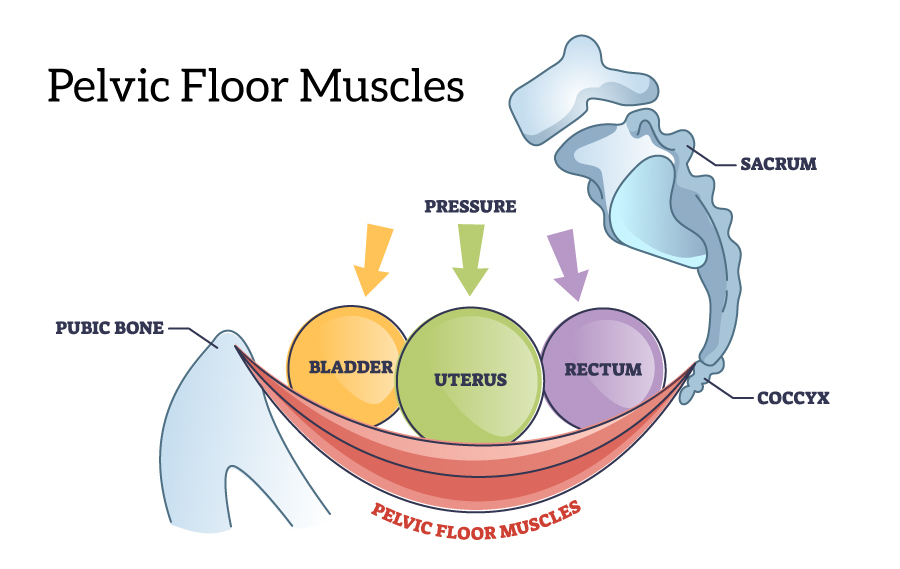The pelvic floor is a group of muscles you might not think about often, but they play a vital role in your daily comfort and overall health. These muscles form a supportive sling, or hammock, at the base of your pelvis, holding key organs like your bladder, uterus (in women), and rectum in place. Just like any other muscle group, the pelvic floor needs to be strong, flexible, and coordinated to function correctly.
When these muscles weaken or become uncoordinated, it can lead to a range of issues that affect your quality of life. Many people silently struggle with these symptoms, often assuming they are a normal part of aging or a consequence of childbirth. At Kaufman Health and Hormone Center, we want you to know that these challenges are not something you simply have to live with. Understanding the signs of a weak pelvic floor is the first step toward finding effective, personalized solutions.
This post will guide you through the functions of the pelvic floor, the common signs of pelvic floor dysfunction, and the steps you can take to regain control and confidence.
More Than Just Strength: The Importance of Coordination
When we talk about muscle health, we often focus on strength. For the pelvic floor, however, coordination is just as important. These muscles must be able to contract (tighten) to maintain continence and support your organs. But they also must be able to relax and lengthen to allow for urination, bowel movements, and comfortable sexual intercourse.
This dynamic ability to contract and relax is key. A pelvic floor that is too tight (hypertonic) can cause as many problems as one that is too weak (hypotonic). The goal is a balanced, responsive system that works in harmony with the rest of your body. Pelvic floor dysfunction occurs when this coordination is lost, leading to a variety of symptoms.
Common Signs of a Weak Pelvic Floor
Pelvic floor issues can manifest in ways that are sometimes surprising. While many associate it with urinary leakage, the signs can be much broader. If you experience one or more of the following, it may be time to pay closer attention to your pelvic health.
Your Quick Checklist for Pelvic Floor Dysfunction
Do you experience any of the following?
- Leakage: Do you leak urine when you cough, sneeze, laugh, or exercise?
- Urgency: Do you have a sudden, strong urge to urinate that’s difficult to control?
- Incomplete Emptying: Do you feel like you can’t fully empty your bladder or bowels?
- Straining: Do you need to strain to start a bowel movement?
- Pain: Do you have pain in your pelvic region, lower back, or during sexual intercourse?
- Pressure: Do you feel a sense of heaviness, bulging, or pressure in your vagina or rectum?
Let’s explore these signs in more detail.
Urinary and Bowel Control Issues
One of the most well-known signs of a weak pelvic floor is stress incontinence—leaking urine when pressure is placed on the bladder from activities like coughing, sneezing, jumping, or lifting. You might also experience urge incontinence, a sudden “gotta go” feeling that sends you rushing to the restroom.
Bowel control can also be affected. This can include accidental leakage of stool or gas, as well as chronic constipation. If your pelvic floor muscles cannot relax properly, it can be difficult to have a complete and comfortable bowel movement, leading to straining.
Pelvic Pressure and Pelvic Organ Prolapse
When the pelvic floor “hammock” loses its supportive strength, one or more pelvic organs can begin to drop or shift downward. This is known as pelvic organ prolapse.
Symptoms of prolapse can include:
- A feeling of heaviness or dragging in the pelvic area.
- A sensation of a bulge or that something is “falling out” of the vagina.
- Lower backache that feels better when you lie down.
- Discomfort during physical activity or standing for long periods.
Pain and Sexual Dysfunction
Pelvic floor dysfunction is a common cause of pain. This can present as chronic pelvic pain, lower back pain without a clear cause, or pain during sex (dyspareunia). For men, pelvic floor weakness can also contribute to erectile dysfunction or a weak ejaculatory force. True intimacy should be comfortable and fulfilling; pain is a signal from your body that something needs attention.

What Causes Pelvic Floor Weakness?
Several factors can contribute to the weakening or dysfunction of the pelvic floor muscles. These risk factors increase the strain on this crucial muscle group over time.
- Pregnancy and Childbirth: The weight of a growing baby and the process of delivery can stretch and damage pelvic floor muscles and connective tissues.
- Aging: Like other muscles in the body, the pelvic floor can naturally weaken with age and hormonal changes associated with menopause.
- Chronic Straining: Frequent constipation, a chronic cough (from smoking, asthma, or allergies), or repeatedly lifting heavy objects improperly can place immense, ongoing pressure on the pelvic floor.
- Weight Gain: Excess body weight increases the load the pelvic floor must support day in and day out.
- Connective Tissue Disorders: Certain genetic conditions, such as Ehlers-Danlos syndromes, can affect tissue quality, making a person more susceptible to pelvic floor issues.
- High-Impact Sports: Long-term participation in activities involving a lot of jumping or running can also contribute to wear and tear.
Myths vs. Facts About Pelvic Health
Misinformation can prevent people from seeking the help they need. Let’s clear up a few common myths.
- Myth: Leaking urine after having a baby is normal and unavoidable.
Fact: While common, it is not “normal.” It’s a sign of muscle dysfunction that can and should be treated. With proper care, most women can significantly improve or resolve postpartum incontinence. - Myth: Kegels are the answer for all pelvic floor problems.
Fact: Kegels can be harmful if done incorrectly or for the wrong reason. If your pelvic floor is already too tight, Kegels can worsen symptoms like pain and constipation. An assessment is needed to know if Kegels are right for you. - Myth: Pelvic floor problems only affect women who have given birth.
Fact: Pelvic floor dysfunction can affect anyone, regardless of gender or parental status. Men, athletes, and women who have never been pregnant can all experience these issues.
What Can You Do? Simple Steps and Professional Care
While professional guidance is key, there are some foundational habits you can adopt to support your pelvic health.
- Practice Healthy Bowel Habits: Avoid straining on the toilet. Try using a small stool under your feet to elevate your knees above your hips, which straightens the rectum and allows for easier passage of stool. Stay hydrated and eat a fiber-rich diet to prevent constipation.
- Breathe Through It: When you lift something heavy, exhale on the effort. Holding your breath increases internal pressure and pushes down on your pelvic floor. Coordinate your breath with the exertion to protect your muscles.
- Mind Your Posture: Slouching can put pressure on your pelvic organs. Sit and stand tall to allow your core and pelvic floor to function in proper alignment.
When to Seek Professional Help
Simple lifestyle changes are helpful, but they often aren’t enough to resolve established pelvic floor dysfunction. The most important step you can take is to seek a professional evaluation. A specialist, such as a urogynecologist, urologist, or a pelvic floor physical therapist, can perform a thorough assessment to understand the specific nature of your issue—whether it’s weakness, tightness, or a coordination problem.
This personalized diagnosis is critical. It ensures you receive the right treatment plan, which may include targeted exercises (that may or may not be Kegels), manual therapy, biofeedback, and education tailored to your body and lifestyle.
Ask About Your Symptoms: Take the First Step Toward Pelvic Health
You don’t have to navigate the signs of a weak pelvic floor alone. We are here to help coordinate the best-individualized care for you and can connect you with vetted local specialists to ensure you receive the most advanced treatments.
We believe in empowering our patients with the knowledge and tools they need to live comfortably and confidently.
You can call us (720) 639-2736, or reach out through the portal to schedule a time to review your concerns. CONTACT US
Frequently Asked Questions
What are the symptoms of a weak pelvic floor?
Common symptoms include urine leakage when you cough, sneeze, or exercise; frequent urges to urinate; constipation or straining during bowel movements; a feeling of pressure or bulging in the pelvic area; pain during intercourse; or a sensation of incomplete bladder or bowel emptying. If you notice any of these, it may be time to seek evaluation.
Can men have pelvic floor dysfunction?
Yes, pelvic floor dysfunction can affect men as well as women. Men may experience issues such as urinary leakage, bowel control problems, or a weak ejaculatory force. It’s important for anyone experiencing symptoms to get a personalized assessment.
Are Kegels always the solution?
No, Kegel exercises are not always the right approach. While they can help strengthen weak pelvic floor muscles, they may worsen symptoms for those whose pelvic floor muscles are too tight or uncoordinated. A specialist can determine the best course of action for your individual needs.
When should I see a specialist?
If you have ongoing symptoms like leakage, pelvic pressure, pain, or trouble with bladder or bowel control that interfere with your daily life, it’s a good idea to consult a pelvic health specialist. Early evaluation allows for personalized care and the best possible outcomes.
What treatments are available for pelvic floor dysfunction?
Treatment options depend on your specific diagnosis and may include physical therapy, targeted exercises, lifestyle changes, medication, or other therapies. Your care team will work with you to find the most effective and comfortable approach for your needs.



